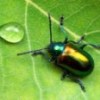
Paratrechina Nylanderia phantasma
Archbold Biological Station, Florida
Here's an ant I almost didn't notice. Paratrechina Nylanderia phantasma is one of the least known insects in North America, active at night and restricted to a particular type of sandy soil in Florida. Workers are only a couple millimeters long and the color of sand. In the field they appear as ghostly little shapes skirting across the ground, scarcely visible even to those looking for them.
Incidentally, N. phantasma was named and described by James Trager, a frequent commentator here at Myrmecos Blog. Perhaps, if we're really nice to him, James will tell us something more about this little ant.
[update 1/12/10, taxonomic change to Nylanderia]
photo details: Canon MP-E 65mm 1-5x macro lens on a Canon EOS 50D
ISO 100, 1/250 sec, f13, flash diffused through tracing paper

Very nice photo. What flash and power did you use? I'm having trouble taking photos with the 1-5x on white backgrounds.
In bit of a rush at the moment, but a few points of interest: A number of ant species are a bit paler in the Lake Wales scrub country than elsewhere, so I at first thought this was just the local version of P. arenivaga. I then noticed that distinctly yellower and these lovely pale creatures lived side by side there at Archbold. Turns out they have different hair counts on the antennal scapes and other little differences, too. By accident, I discovered that /phantasma smells different when crushed than its yellow sister species, the former a bit like rose oil, the latter somewhat acidic.
Interestingly, phantasma has spread north out of the Lake Wales Ridge where it presumably evolved, and up in Putnam County, it is yellower, but retains the morphological and aromatic differences that distinguish it. So this ant in fact does conform to the Lighter-on-the-Ridge "rule".
Alex- Would you mind posting a close-up of the head? I am having a hard time telling what's the more pigmented structure one can see through the transparent cranial cuticle (the tendons of the mandibles, the tentorium, the brain?).
Recently, I have collected similar ants in the Jalapão desert, state of Tocantins, central Brazil. These ants are also nocturnal, unpigmented, and possess huge eyes. However, they belong to the genus Dorymyrmex. I have sent some workers to the Argentine colleague Fabiana Cuezzo (Dorymyrmex expert) and she confirmed that our pale ant belongs to an undescribed species. Would it be "Dorymyrmex phantasma sp. n."????
Rodrigo- That of course will be up to Fabiana.
To wit, I thought the recently described Martialis more ghostly in appearance than Martian, but the authors had their own discretion about it, notwithstandind its paleness, ancientness and undisputable earthliness.
By the way, there is another rather pale Paratrechina, namely P. pallida from New Guinea, in this case apparently related to the much darker and far more well-travelled P. longicornis.
"By accident, I discovered that /phantasma smells different when crushed than its yellow sister species, the former a bit like rose oil, the latter somewhat acidic."
That's an awesome snippet. Never would have occurred to me (but then, I'm not even a scientist, just a fan).
As an outsider, I'm grateful to be able to listen in on this sort of thing. Thanks!
Glad you noticed that, Mike. I sniffed a lot of ants after discovering that, to see what other distinctions I might notice.
I noticed it because I recalled reading that in earlier times, smell and taste were characteristics alchemists/chemists used to analyse chemicals and I know people use scent from crushed leaves to identify plants. For obvious reasons, the use of the chemical senses has fallen out of favour in chemistry. :-)
Have you noticed scent distinctions with other ants?
Note that P. pallida is now called by the rather redundant-sounding Paraparatrechina pallida and the subject of this blog is now properly called Nylanderia phantasma. Only P. longicornis gets to stay home in Paratrechina, and it apparently is not so closely related to either of the others.
See http://myrmecos.wordpress.com/2010/01/09/paratrechina-is-so-2009-nyland…